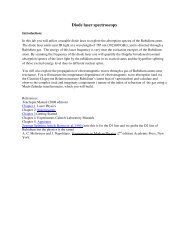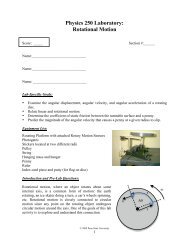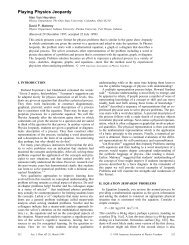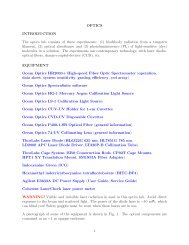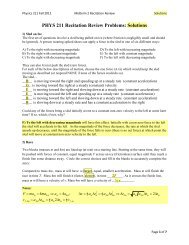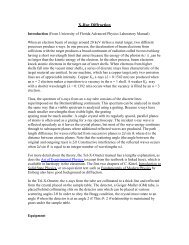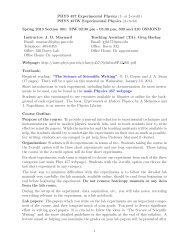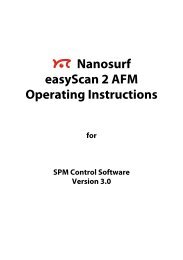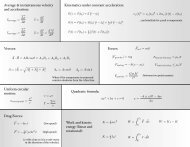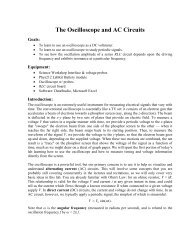Understanding RL Circuits (Lab 9)
Understanding RL Circuits (Lab 9)
Understanding RL Circuits (Lab 9)
You also want an ePaper? Increase the reach of your titles
YUMPU automatically turns print PDFs into web optimized ePapers that Google loves.
PHYS 212 <strong>Lab</strong> <strong>Understanding</strong> <strong>RL</strong> <strong>Circuits</strong> 2<br />
where B is the magnetic flux through the inductor. This magnetic flux is the flux created<br />
through the inductor by the current which passes through it (this is why inductance is more<br />
properly called “self-inductance”). The inductors we encounter are often made of many turns of<br />
wire and so it can be useful to note that the magnetic flux could be looked at as the magnetic flux<br />
created by one turn of wire ( B-one ) multiplied by the number of turns of wire (N) making the<br />
inductor. In other words, the more turns of wire an inductor has, the larger its inductance will be.<br />
The inductance can also be increased by placing a ferromagnetic material within the center of the<br />
inductor. The magnetic field created by the inductor in the current will magnetize this core; as<br />
the inductor’s magnetic field changes so will the magnetization of the core. This in turn will<br />
correspond to a larger change in flux.<br />
When an inductor is connected in series with a resistor of resistance R and a power supply or<br />
battery with EMF , the inductor will oppose any change in flux (by trying to keep the current at<br />
its initial value, zero). This will cause the voltage across the inductor to spike. The voltage<br />
across the inductor then decays with time. As the inductor opposes the change in current, the<br />
current will increase rapidly at first, then the rate at which the current changes will decrease as it<br />
eventually reaches a final steady-state value. This process is described by the equations<br />
<br />
<br />
<br />
t<br />
i t 1 e <br />
<br />
<br />
(Eq. 3)<br />
R <br />
and<br />
V<br />
L<br />
t<br />
<br />
t<br />
<br />
e<br />
(Eq. 4)<br />
As with an RC circuit, the quantity t is called the time constant of the circuit. For an <strong>RL</strong> circuit,<br />
the time constant is given by<br />
L<br />
<br />
(Eq. 5)<br />
R<br />
If an inductor has a current through it and then is removed from the battery in such a way that it<br />
is still connected to a resistance R, the inductor will still oppose any change in flux (by trying to<br />
keep the current at its initial value and direction, whatever those are). The current through the<br />
inductor will decrease rapidly but then the rate will slow as it approaches zero. This process is<br />
described by the equations<br />
t<br />
<br />
it<br />
e<br />
(Eq. 4)<br />
R<br />
and<br />
V<br />
L<br />
t<br />
<br />
t<br />
<br />
e<br />
(Eq. 5)



